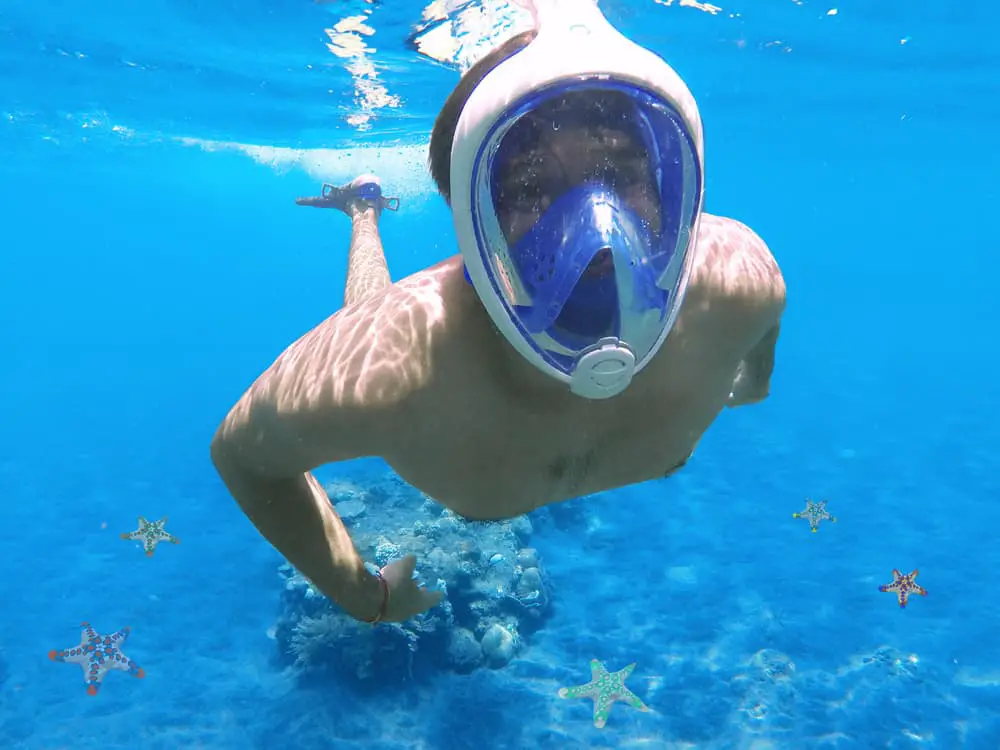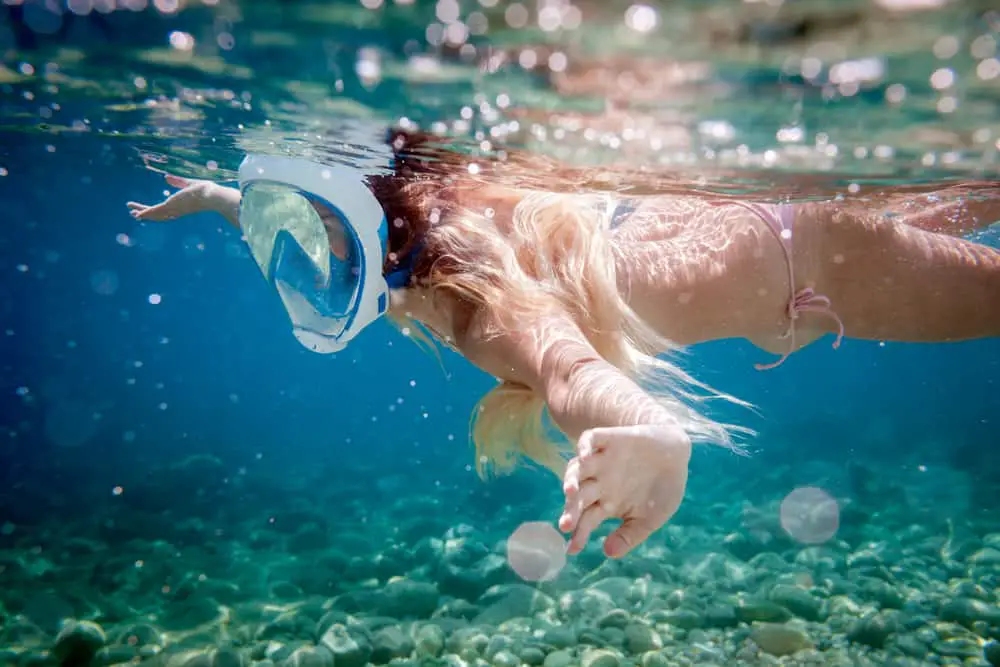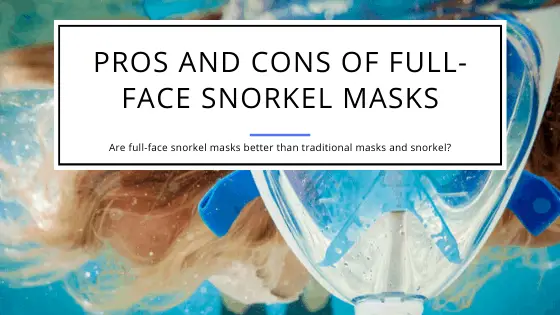Pros and Cons of Full-Face Snorkel Masks
When you go scuba diving, there are a few essential pieces of equipment without which your dive would be impossible. Your air tanks, regulator, wetsuit, BCD, fins and mask, and snorkel are absolutely essential pieces of equipment. Within each piece of equipment, you can get a variety of different kinds, and this is true for your mask and snorkel too.
Full-face masks were first retailed in 2014 by Ocean Reef. By 2015, these masks had gained popularity with scuba divers and snorkelers all over the world. Though a lot of thought went into making these masks a safe and popular option for divers, there are still some naysayers and for good reason. The full-face mask has its advantages for sure, but that does not mean it doesn’t come with its own challenges. To get into the pros and cons of using this equipment, first, we need to understand what it is:
What are Full-Face Snorkel Masks?
A full-face snorkel is an improved version of the traditional mask and snorkel. It covers the entire face rather than just the eyes and does not require a mouthpiece.
The high-tech design of the mask claims that there will be no fogging; this is because the mask has a separate chamber where you can use your nose and mouth to breathe. The mask also gives divers a wider field of vision because the design does not have any obstructions on the corners of the eyes.
How Are Full-Face Snorkel Masks Different From Traditional Masks And Snorkel Sets?
Traditional snorkel mask and snorkel sets are what you are used to seeing in most scuba diving experiences. They are the large set of goggles with a rectangular piece of either plastic or tempered glass; this is what you see out of. Then, there is a piece of silicon, which is used to cover your nose and reduce as much fog as possible within the goggles, and also keep water from entering your nostrils.
The mask is secured to your face with the help of a thick rubber strap that can be adjusted to fit your face. The snorkel is made of a plastic and silicone mouthpiece that is attached to a plastic breathing tube. The mouthpiece is used for breathing through the mouth.
Full-face masks look like something out of a futuristic Hollywood production. The scuba versions of full-face masks cover the whole face and have an area where you can attach your regulator. They are reminiscent of HazMat masks that you usually see in apocalypse-themed movies.
The masks have two sections; the top section is where you view from and the bottom is for your nose and mouth – where you breathe from. These masks have built-in snorkels, so you don’t have to worry about putting in a mouthpiece, you can just breathe naturally. They have comfortable silicon lining that circles the face and keeps it in place, along with a thick adjustable rubber strap to secure them.
What Are The Advantages of Full-Face Snorkel Masks?
Better View
The full-face mask gives the diver a larger scale of peripheral vision compared to their traditional counterparts. This is one of the biggest advantages of using a full-face mask.
Natural Breathing
Another reason why these masks became so popular is the ease of breathing. You aren’t required to wear a mouthpiece, and your nose is not covered; this means you can breathe naturally like you would above water.
No Fog
Because your nose and mouth are in a separate chamber, your breath is not going to fog up your vision. This can be a huge problem with traditional masks. The built-in ventilation system of full-face masks prevents your breath from leaking into the vision chamber and fogging the plastic.
No Jaw Fatigue
Full-face masks are equipped with built-in snorkels, which means there is no need to put in a mouthpiece. Traditional snorkels require you to fit something in your mouth, which can cause jaw fatigue during the dive.
No Leaks
With traditional masks, any kind of facial expressions and movements can break the silicon shield and let water into your mask. This is not the case with full-face masks. They skirt the entire face, so there is a lot more freedom for expression without worrying about leaks.
Less Claustrophobia
Though it might not seem like the case because you are using a mask to trap your entire face, the use of natural breathing and extended view in full-face masks (like the Seaview 180 Degree V2) actually is a lot less claustrophobic than traditional snorkels.
Evaluation of the Subea/Tribord Easybreath Full-Face Snorkeling Mask

What Are The Downsides Of Full-Face Snorkel Masks?
Complicated Defogging
If your full-face mask does not fit properly, the seal is not properly created. This can cause fogging and leaks. When a full-face mask needs to be defogged, it requires the whole mask to come off, unlike traditional masks that can just be lifted at an angle.
CO2 Buildup
This break in the seal can lead to Carbon Dioxide buildup that can be caused by shallow breathing while wearing the mask. CO2 buildup is very dangerous as it can lead to loss of consciousness. This is the biggest danger of these full-face masks which you can avoid when you buy a high-quality mask.
No Glasses
While wearing a full-face mask, you cannot wear glasses that you might need to see. The arms of the glasses will cause a break in the seal around the face.
Bulky
Full-face masks are larger and heavier than traditional masks. They require extra room when you are planning to travel with them, and likely a separate compartment because the plastic can get scratched easily.
Plastic is Damageable
Full-face masks are usually made of plastic, which can easily get scratched. You will need to keep them protected while transporting them, during your dive and even after you are done using them.
No Free Diving
Full-face masks are only suitable for shallow dives. Deep dives are not possible because of pressure buildup. These masks are not equipped to equalize pressure on deep dives, thus, they are not used.
Are They Safe?
There are a lot of myths and facts that are associated with the safety of full-face snorkel masks, so it sometimes gets hard to distinguish which is which. The thing is, most myths regarding the safety of these masks stems from the use of cheaply made knock-offs.
If you are using a well-made mask from a trusted manufacturer, these masks are safe and are continuing to be improved upon by designers. Of course, there are situations like deeper dives where these masks are not viable, but otherwise, they’re safe to use!
Are They Better Than A Traditional Mask And Snorkel?
There is a reason why these masks are becoming so popular. They are much easier to use, have better vision, have a more natural style of breathing and don’t require an extra mouthpiece. That does not mean that these masks are the end-all-be-all for masks.
There are still times when traditional masks are required, like when you need to go on a deeper dive. Also, it is very important to make sure you are getting a high-quality mask from a trusted manufacturer. Cheaply made masks can be very dangerous and even fatal as they have not gone through rigorous testing to ensure their safety.

Final Thoughts
Full-face or traditional, this is a choice of personal preference. Most instructors recommend trying both so you have experience with both techniques and then you can choose your preference. Traditional masks require a little more training but will teach basic skills of controlled breathing, which can be essential in a time of need. Go out, try them both, then pick your preferred method!

